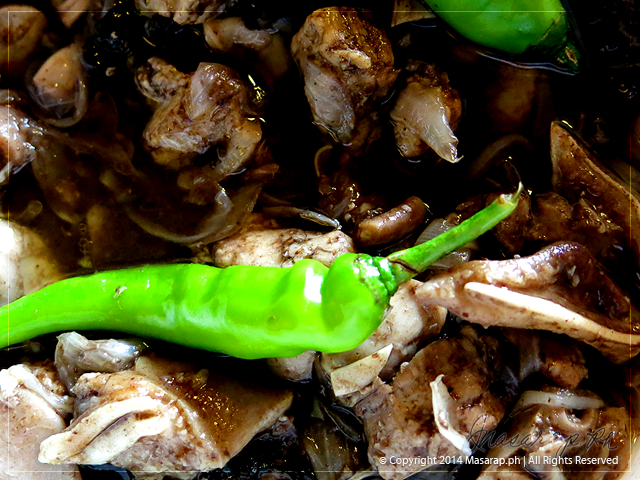Filipinos can be very choosy about how they like their dinuguan; some like it dark with blood and the others prefer the pale, whitish one. Fear not, we are not the only “vampiresâ€, blood eating people; blood pudding and sausages are also served in other counties too!
 The secret to good dinuguan is the amount of vinegar used; that it is eaten the day after it’s cooked; and how well the intestines are cleaned (very important). To make it the dark kind, some of the blood must be mashed and added with the cooking early on. This recipe is the pale kind or Pampanga style. A good friend, Cora Ballestamon, likes to put in slices of liver and a spoonful of sugar in her version of dinuguan.
Ingredients:
- 1 kilo pigs ears – cut into 2-inch long by 1-inch wide pieces
- 1 1/2 kilo porks’ Fallopian tubes or pork small intestines
- 1/2 kilo soft bone pork cut into 1-inch pieces or pork belly (liempo) – cut into 1/2- inch cubes
- 2 cups pork blood aka pork blood jelly – slice into 1/2-inch by 1-inch pieces (if you want to have the dark kind, save the liquid that comes out and use to darken the stew)
- 1/4 cup cooking oil`
- 2 tablespoons crushed garlic
- 1 cup thinly sliced onions
- 1 cup palm vinegar
- 2 cups water or pork broth
- 2 bay leaves
- 1 teaspoon dried oregano leaves
- 1 teaspoon freshly ground black peppercorns
- 2 pieces siling mahaba (lady finger chili)
- salt to taste – start with 1 teaspoon
Cleaning the ears, and intestines:
- In the Western world and in Australia, the pigs ear is already clean; one can just remove the forgotten hair here and there. In the Philippines, we have to use a sharp knife to scrape off the hair, the thin membrane around the inner ears’ opening. That being done, proceed to cut them into size; bite size.
- Place the ears in a cooking pot with enough water to more than cover the ears; add a teaspoon of peppercorns, 1 bay leaf, and simmer till the ears are tender but still crunchy.
- If one can find fallopian tubes, they don’t need cleaning; just a good wash and cut into 2-inch lengths.
- Place fallopian tubes in pot with equal amounts of water and vinegar to cover the tubes and simmer till tender. Drain from cooking liquid and save cooking liquid.
- The tricky one is the small intestines. First they have to be washed well and whatever is left inside, be totally removed.
- Then cut into 2 inches length.
- In a glass or plastic bowl, dissolve a marble size of alum (tawas) in enough water to cover the intestines and soak the intestines for 1/2 hour. This will remove the smell of the intestines.
- In a non-corrosive cooking pot, place equal amount of vinegar and water and simmer the intestines till very tender. When tender, drain from cooking liquid and set aside. Throw the cooking liquid.
Procedure:
- In a medium sized, non-corrosive cooking pot (ceramic or glass type), over medium-low fire, warm the pot for 1 minute and then pour in the cooking oil and warm for another minute.
- Add the garlic and sauté till the garlic is light gold.
- Add the onions and continue to saute till the onions are limp and translucent.
- Add in the soft bone pork or pork belly and saute for 2 minutes.
- Pour in the vinegar and broth, peppercorn, bay leaves and oregano leaves, and siling mahaba and continue to simmer over low fire till the pork is almost tender; about half an hour or so.
- Then add in the pork ears, fallopian tubes or small intestines and continue to simmer for about 15 minutes.
- (If you want to have the dark Dinuguan, this is the point where in you add the liquid blood and some solidified blood that has been sliced into small slivers (1/4-inch by 1-inch). Add the blood together with the ears etc.)
- To make the Dinuguan the white version, after the simmering of the ears and tubes, add just the solid blood that has sliced and simmer for another 15 minutes.
- Taste the Dinuguan and adjust according to your taste. Add salt at this point. You can add crushed black pepper too.
- Simmer for another five minutes and cool.
- Do not eat the same day it has been cooked.
- Serve with hot steaming rice.


Recent Comments